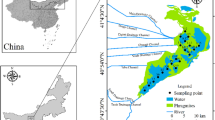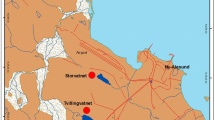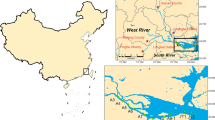Abstract
Purpose
The distribution and speciation of mercury in surface water of East River, Guangdong province, China were investigated.
Methods
All told 63 water samples were collected during a bi-weekly sampling campaign from July 15th to 26th, 2009.
Results
Total mercury (THg) concentrations in water samples ranged from 11 to 49 ng/L. Maximum levels of THg were measured in the lower reaches of East River, where it passes through a major industrial area adjacent to Dongguang city. Higher ratios of dissolved mercury (THg (aq)) in proportion to THg were restricted to the downstream section of East River. Concentrations of the minor constituent methyl mercury varied in the range from 0.08 to 0.21 ng/L. On average, methyl mercury made up 0.8% and 0.56% of THg (aq) and THg, respectively. Dissolved species dominated the speciation of methyl mercury in proportions up to 81%, which may imply that methyl mercury is largely produced in situ within the river water. Environmental factors (such as water temperature, dissolved oxygen, etc.) are regarded to play an important role in Hg methylation processes were monitored and assessed.
Conclusions
In an international perspective, East River must be classified as a polluted river with considerably sources within its industrial areas. The THg (aq) and particle mercury fluxes to the Pearl River Estuary by East River run-off were estimated to be 0.31 ± 0.11 and 0.17 ± 0.13 t/year, respectively. Hence, in total nearly 0.5 t Hg is annually released to the sea from the East River tributary.



Similar content being viewed by others
References
Boudou A, Ribeyre F (1997) Mercury in the food web: accumulation and transfer mechanisms. In: Sigel A, Sigel H (eds) Mercury and its effects on environment and biology. Metal Ions in Biological Systems, vol.34. Marcel Dekker, New York, pp 289–319
da Silva DS, Lucotte M, Roulet M, Poirier H, Mergler D et al (2005) Trophic structure and bioaccumulation of mercury in fish of three natural lakes of the Brazilian Amazon. Water Air Soil Pollut 165:77–94
Domagalski JL, Alpers CN, Slotton DG, Suchanek TH, Ayers SM (2004) Mercury and methylmercury concentrations and loads in the Cache Creek watershed, California. Sci Total Environ 327:215–237
Faganeli J, Horvat M, Covelli S, Fajon V, Logar M, Lipej L, Cermelj B (2003) Mercury and methylmercury in the Gulf of Trieste (northern Adriatic Sea). Sci Total Environ 304:315–326
Feng XB, Streets D, Hao JM, Wu Y, Li GH (2009) Mercury emissions from industrial sources in China. In: Pirrone N, Mason R (eds) Mercury fate and transport in the global atmosphere., pp 67–79. doi:10.1007/978-0-387-93958-2_3
Fitzgerald WF, Engstrom DR, Mason RP, Nater EA (1998) The case for atmospheric mercury contamination in remote areas. Environ Sci Technol 32:1–7
Fu J, Mai B, Sheng G, Zhang G, Wang X, Peng P, Xiao X, Ran R, Cheng F, Peng XZ, Wang Z, Tang UW (2003) Persistent organic pollutants in environment of the Pearl River Delta, China: an overview. Chemosphere 52:1411–1422
Fu X, Feng X, Zhang G, Xu W, Li X, Yao H, Liang P, Li J, Sommar J, Yin R, Liu N (2010) Mercury in the marine boundary layer and seawater of the South China Sea: concentrations, sea/air flux, and implication for land outflow. J geophys res 115:D06303. doi:10.1029/2009JD012958
Gill GA, Bruland KW (1990) Mercury speciation in surface freshwater systems in California and other areas. Environ Sci Technol 24:1392–1400
Goto D, Wallace WG (2009) Biodiversity loss in benthic macroinfaunal communities and its consequence for organic mercury trophic availability to benthivorous predators in the lower Hudson River estuary, USA. Mar Pollut Bull 58(12):1909–1915
Hamilton DP, Schladow SG (1997) Prediction of water quality in lakes and reservoirs. Part I: model description. Ecol Model 96:91–110
Ho KC, Hui KCC (2001) Chemical contamination of the East River (Dongjiang) and its implication on sustainable development in the Pearl River Delta. Environ Int 26:303–308
Ho KC, Chow YL, Yau JTS (2003) Chemical and microbiological qualities of the East River (Dongjiang) water, with particular reference to drinking water supply in Hong Kong. Chemosphere 52:1441–1450
Ip CCM, Li XD, Zhang G, Wai OWH, Li YS (2007) Trace metal distribution in sediments of the Pearl River Estuary and the surrounding coastal area, South China. Environ Pollut 147:311–323
Jiang GB, Shi JB, Feng XB (2006) Mercury pollution in China. Environ Sci Technol 40(12):3672–3678
Johansson K, Bergback B, Tyler G (2001) Impact of atmospheric long range transport of lead, mercury and cadmium on the Swedish forest environment. Water Air Soil Pollut Focus 1:279–297
Langer CS, Fitzgerald WF, Visscher PT, Vandal GM (2001) Biogeochemical cycling of methylmercury at Barn Island salt marsch, Stonington, CT, USA. Wetlands Ecol Mang 9:295–310
Lawson NM, Mason RP, Laporte J-M (2001) The fate and transport of mercury, methylmercury, and other trace metals in Chesapeake Bay tributaries. Water Res 35:501–515
Liang L, Horvat M, Bloom NS (1994) An improved speciation method for mercury by GC/CVAFS after aqueous phase ethylation and room temperature precollection. Talanta 41:371–379
Liu Q (1999) Flux of mercury into the sea and analysis and countermeasure on pollution. Pearl River 6:44–47 (in Chinese)
Mason RP, Fitzgerald WF, Morel FMM (1994) The biogeochemical cycling of elemental mercury: anthropogenic influences. Geochim et Cosmochim Acta 58:3191–3198
USEPA Method 1630 (2001) Methyl mercury in water by distillation, aqueous ethylation, purge and trap, and CVAFS, January Draft 2001. US Environmental Protection Agency, Office of Water, Office of Science and Technology Engineering and Analysis Division (4303), 1200 Pennsylvania Avenue, NW, Washington, DC. 20460, p. 1–41
USEPA Method 1631 (1999) Mercury in water by oxidation, purge and trap, and cold vapor atomic fluorescence spectrometry. United States Environmental Protection Agency, Office of Water 4303, EPA-821-R-99-005; Washington, p. 1–33
Mitchell CPJ, Branfireun BA, Kolka RK (2008) Spatial characteristics of net methylmercury production hot spots in peatlands. Environ Sci Technol 42(4):1010–1016
Molisani MM, Kjerfve B, Barreto R, Lacerda LD (2007) Land-sea mercury transport through a modified watershed, SE Brazil. Water Res 41:1929–1938
CN-EPA (China National Environmental Protection Agent) (2002) Environment quality standard for surface water, GB3838-2002. (in Chinese)
Paller MH, Jagoe CH, Bennett H, Brant HA, Bowers JA (2004) Influence of methylmercury from tributary streams on mercury levels in Savannah River Asiatic clams. Sci Total Environ 35:209–219
Paraquetti HHM, Ayres GA, Almeida MD, Molisani MM, Lacerda LD (2004) Mercury distribution, speciation and flux in the Sepetiba Bay tributaries, SE Brazil. Water Res 38:1439–1448
Rolfhus KR, Fitzgerald WF (1995) Linkages between atmospheric mercury deposition and the methylmercury content of marine fish. Water Air Soil Pollut 80:291–297
Schäfer J, Blanc G, Audry S, Cossa D, Bossy C (2006) Mercury in the Lot-Garonne River system (France): Sources, fluxes and anthropogenic component. Appl Geochem 21:515–527
Shi JB, Ip CCM, Zhang G, Jiang GB, Li XD (2010) Mercury profiles in sediments of the Pearl River estuary and the surrounding coastal area of South China. Environ Pollut 158:1974–1979
Ullrich SM, Tanton TW, Abdrashitova SA (2001) Mercury in the aquatic environment: a review of factors affecting methylation. Crit Rev Environ Sci Tech 31(3):241–293
USEPA (1992) Water quality standards; establishment of numeric criteria for priority toxic pollutants, states compliance; final rule. Fed. Regist. 40 CFR Part 131, 57/246
Vandal GM, Fitzgerald WF (1995) A preliminary mercury budget for Narragansett Bay (Rhode Island, USA). Water Air Soil Pollut 80:679–682
WHO (2008) Guidelines for drinking water quality, 3rd edn. World Health Organization, Geneva, Switzerland
Wiener JG, Knights BC, Sandheinrich MB, Jeremiason JD, Brigham ME, Engstrom DR, Woodruff LG, Cannon WF, Balogh SJ (2006) Mercury in soils, lakes and fish in Voyageurs National Park (Minnesota): importance of atmospheric deposition and ecosystem factors. Environ Sci Technol 40:6261–6268
Yan H, Feng X, Tang S, Shang L, Wang S, Dai Q, Hou Y (2003) The concentration and distribution of different mercury species in the water columns of Baihua reservoir. J Phys IV France 107:1385–1388
Zhang J, Feng X, Yan H, Guo Y, Yao H, Meng B, Liu K (2009a) Seasonal distributions of mercury species and their relationship to some physicochemical factors in Puding Reservoir, Guizhou, China. Sci Total Environ 408:122–129
Zhang XL, Luo XJ, Chen SJ, Wu JP, Mai BX (2009b) Spatial distribution and vertical profile of polybrominated diphenyl ethers, tetrabromobisphenol a, and decabromodiphenylethane in river sediment from an industrialized region of South China. Environ Pollut 157:1917–1923. doi:10.1016/j.envpol.2009.01.016,2009
Acknowledgement
This study was financially supported by Chinese Academy of Sciences (grant KZCX2-YW-Q02-01). We would like to thank our co-workers Gan Zhang, Lingping Zeng, Xiang Liu, Jizhong Wang from Guangzhou Institute of Geochemistry, and Zhuanxi Luo from Institute of Urban Environment for assistance with sampling.
Author information
Authors and Affiliations
Corresponding author
Additional information
Responsible editor: Vera Slaveykova
Rights and permissions
About this article
Cite this article
Liu, J., Feng, X., Zhu, W. et al. Spatial distribution and speciation of mercury and methyl mercury in the surface water of East River (Dongjiang) tributary of Pearl River Delta, South China. Environ Sci Pollut Res 19, 105–112 (2012). https://doi.org/10.1007/s11356-011-0542-0
Received:
Accepted:
Published:
Issue Date:
DOI: https://doi.org/10.1007/s11356-011-0542-0




